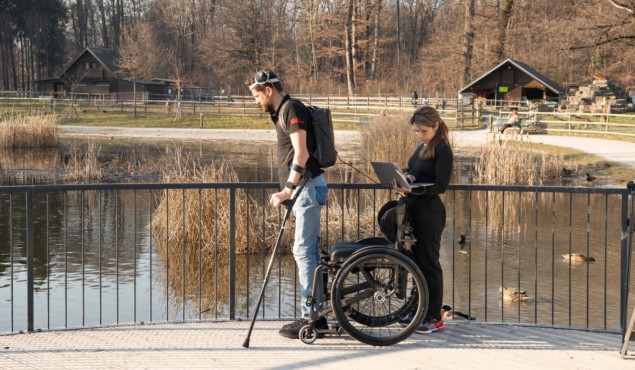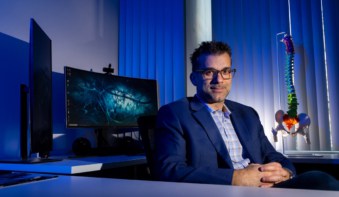
To initiate walking, the brain sends commands to neurons located in the lumbosacral spinal cord – the region of the spine that controls leg movement. If an injury interrupts this communication between brain and spinal cord, it can cause permanent paralysis.
Researchers have now developed a brain–spine interface (BSI) that can restore this communication. They demonstrated that the device, described in Nature, could help an individual with paralysis of the arms and legs to stand and walk naturally.
“What we have been able to do is re-establish the communication between the brain and the region of the spinal cord controlling movement, using a digital bridge,” the study’s co-lead author Grégoire Courtine, from Ecole Polytechnique Fédérale de Lausanne (EPFL) in Switzerland, explained in a press briefing. “We captured the thoughts of [the participant] and translated these into stimulation of the spinal cord to induce leg movement.”
The BSI comprises two fully implantable systems that record cortical activity and stimulate the lumbosacral spinal cord in real time. To monitor electrocorticographic (ECoG) signals from the brain, the team used a 64-channel electrode grid embedded in a 50 mm diameter titanium case with the same thickness as the skull.
A processing unit uses ECoG signals recorded from brain regions that control movement to predict the user’s motor intentions, and then converts these intentions into stimulation commands that activate leg muscles. Electrical stimulation is delivered to the targeted region using an implantable pulse generator connected to a 16-electrode paddle lead. The whole system operates wirelessly, allowing the user to move around independently.
“We developed brain–machine interface technology based on unique implantable medical devices, named WIMAGINE, that are able to record the brain activity at the surface of the cortex,” says co-lead author Guillaume Charvet, head of the BCI programme at CEA-Leti’s Clinatec, in France. “We also developed a dedicated algorithm based on artificial intelligence methods able to decode in real time the intention of movement of the patient.”
Clinical trial
To test the BSI, the researchers recruited a 38-year-old male who had an incomplete cervical spinal cord injury from a bike accident 10 years earlier. He had previously participated in the STIMO trial, which involved targeted epidural electrical stimulation of the spinal cord. This enabled him to regain the ability to step with the help of a front-wheel walker. However, after three years of regular training with stimulation only, he had reached a plateau of recovery, motivating him to enrol in this latest study – STIMO-BSI.
Jocelyne Bloch, co-lead author and a functional neurosurgeon at Lausanne University Hospital, surgically implanted two recording devices on the participant’s brain (on regions of the cerebral cortex that respond to the intention to move the left and right lower limbs) and the paddle lead on his lumbar spinal cord.
The researchers first calibrated the BSI to select features of ECoG signals linked to the intention to move, and to configure stimulation programmes that modulate specific groups of lower limb muscles. They then used a multilinear algorithm that linked ECoG signals to the control of stimulation parameters. In just a few minutes, the algorithm calibrated a BSI that enabled the participant to control hip deflection.

To support walking with crutches, the team selected stimulation programmes that targeted muscles associated with weight acceptance, propulsion and swing functions. After several minutes of training with the BSI, the participant was able to walk naturally and independently. When the BSI was turned off, he instantly lost the ability to take steps; walking resumed as soon as it was turned back on.
The researchers note that after the original STIMO trial, the participant regained basic walking ability during stimulation and partial mobility without stimulation. However, he had difficulty transitioning from standing to walking and stopping, and could only walk over flat surfaces. Using the BSI enabled him to climb up and down a steep ramp with ease, climb stairs, negotiate obstacles and traverse changing terrains, all using the same BSI configuration. The BSI remained reliable and stable for over one year of use, including at home without supervision.
Functional recovery
After completing 40 sessions of neurorehabilitation – walking with BSI, single-joint movements with BSI, balance with BSI and standard physiotherapy – the participant was able to walk with crutches, even when the implant was switched off and exhibited improvements in all conventional clinical assessments.
These improvements without stimulation translated into a meaningful increase in his quality-of-life, such as walking independently around the house, getting in and out of a car, or sharing a beer standing at a bar with friends.

Wireless implant uses optogenetics to control spinal cord activity in mice
“My wish was to walk again and I believed it was possible. I tried many things before and now I have to learn how to walk naturally again,” the participant, Gert-Jan, reported in the press briefing. “I can walk at least 100 or 200 metres, depending on the day, and I can stand for two or three minutes unsupported.”
When asked to compare the BSI to the spinal-cord stimulation in the STIMO trial, he explained that stimulation alone didn’t feel completely natural. “The stimulation before was controlling me; now I am controlling the stimulation by my thoughts, that’s the big difference,” he said.



